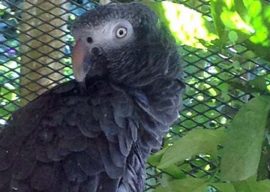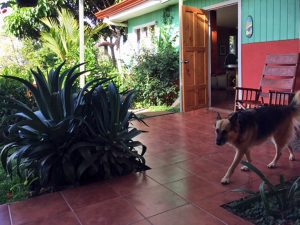
Frank’s open door as seen from my rocking chair on the porch
Throughout the five months of medical treatments, surgeries and doctor visits I saw myself move haltingly through the many ups and downs. All kinds of emotions bumped along in the seemingly endless days and nights.
I was house bound for most of the time. And confined to only the parts of my house that I could get to on the knee scooter: the main part of my house (minus the kitchen that was out of reach because of a step), my front porch and the bathroom of Frank’s house across the porch. Various friends came to spend an afternoon or a night with me and helped to fill the hours and days. And my primary care was through my Tico family – Anita and Billy.
While plodding along in the now familiar daily routines I noted the edges of depression in some of my thoughts. Because of some serious bouts with clinical depression in my past, I recognized the signs. I knew it was anger that I had turned onto myself and that I needed to monitor my thoughts and see what I could do to mitigate my essential disappointment that I wasn’t doing better. Faster. Usually I could distract myself for awhile as I desperately looked forward to some event that could provide relief, possibly even joy. A visit with a good friend. A movie. A book.
My next big known and planned for event would be my pulmonary biopsy that didn’t exactly provide anticipation. But it was a goal and I knew I needed to be walking when it happened – Doctor’s orders. Most importantly this planned event coincided with something I really looked forward to – the arrival of two of my sons, Mike and Tim. They would meet me in Hospital Biblica for my lung biopsy in San Jose.
I just had to get through the next two months.
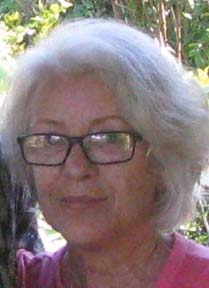 A good friend Marie came to stay with me for a few days in early June, which cheered me up. It was good to be with another artist and to paint together.
A good friend Marie came to stay with me for a few days in early June, which cheered me up. It was good to be with another artist and to paint together.
And then the unthinkable happened.
Marie was getting ready to feed the dogs when suddenly Seurat just collapsed. He was lying on the floor and struggling to get to his feet. Marie helped him to lie down and called her husband Randy, who was fortunately nearby and able to come help.
When Seurat finally got to his feet, his head was turned to the side and he had difficulty walking. His right side, including his mouth was functionally impaired. Randy carried Seurat to his car and drove off to the vet, Dr. Solano. In a few hours Randy returned with Seurat and news that the doctor thought it was either an inner ear inflammation that caused his imbalance or he was in the process of dying. He was, after all 105 in dog years. We would have to wait and see over the next few days how he responded to the prednisone.
It was another huge shock for me.
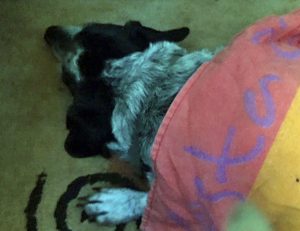 Though Marie and Anita helped to created comfortable beds for him near my usual places ( my desk and bed) I felt helpless. I ached to hold him – but I could not get down to his level or lift him to mine. I ached to comfort him, but all I could do is reach from my chair down to his head. The thought of losing Seurat re-ignited my depression and I struggled to find ways to distract myself and to keep moving forward. Mostly I managed it by focusing on the incremental things I could do for him. Because he could only manage one bite of food at a time, I fed him from my hand several times a day for the first several days while we watched for any signs of improvement.
Though Marie and Anita helped to created comfortable beds for him near my usual places ( my desk and bed) I felt helpless. I ached to hold him – but I could not get down to his level or lift him to mine. I ached to comfort him, but all I could do is reach from my chair down to his head. The thought of losing Seurat re-ignited my depression and I struggled to find ways to distract myself and to keep moving forward. Mostly I managed it by focusing on the incremental things I could do for him. Because he could only manage one bite of food at a time, I fed him from my hand several times a day for the first several days while we watched for any signs of improvement.
Seurat very slowly improved as time inched forward to the end of July.
Finally a respite with the days feeling more brilliantly upbeat as my lung surgery day approached along with two weeks with sons Tim and Mike. My Achilles wound continued its slow progress and Seurat was able to eat and walks slowly. Dr. Mario gave his permission for me to also walk a few steps – to use the bathroom and each step felt wonderful.
Soon Billy and I were off to San Jose for the lung biopsy via thoracoscopy. The surgery went well and I joyfully relaxed into the comfort of family for the two weeks afterwards. Our activities were mainly housebound, but we managed a few short trips out to eat. Tim stayed an extra week to be with me to get the anticipated results of the biopsy
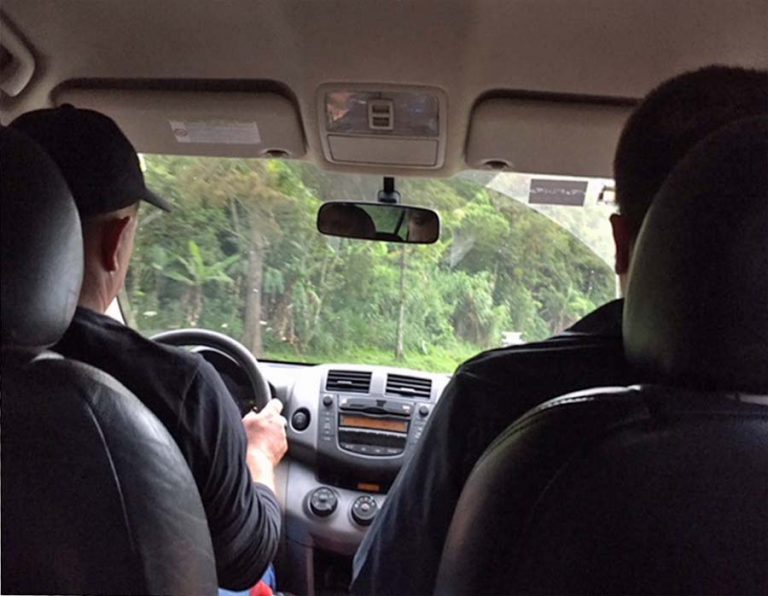
Pilot Billy; Co-pilot Tim
I felt hopeful and rested as Billy, Tim and I drove once again to San Jose for the Saturday morning meeting with the lung team – Drs. Rojas, pulmonologist and Guido, thoracic surgeon. We were eager to hear the specific ILD and Pathology report so that specific drug treatment could happen
Dr. Rojas Looked directly into my eyes and said that he had gone through my website after receiving the biopsy Pathology report. As I briefly wondered to myself if he was interested in art, he clarified that his focus was on my long association with birds – particularly parrots and pigeons. It made sense to him because the specific type of ILD that I had is called ‘Bird Keeper’s Lung’ or ‘Pigeon Breeder’s Lung’, which is a type of hypersensitivity pneumonitis triggered by exposure to avian proteins present in the dry dust of birds. I felt the cold chill in my first realizations that what he was describing had likely originated back in New Mexico with my two flocks of racing pigeons. He went on to stress that it was possible that I had a genetic predisposition to this ILD, but the many years of exposure had taken their toll. My mind caressed the memory of several particular pigeons I’d loved. I saw them flying free in the blue blue New Mexico sky. And then I thought of the other birds in my indoor life back then – the four parrots that occupied my indoor office adjacent to my bedroom. I had brought them with me to Costa Rica 10 years ago, and likely further exacerbated the progression of my disease. Now there was only Sage, my African Grey parrot and one of my closest friends.
Dr. Rojas was still talking when my attention returned to what he was saying about the first thing I needed to do – before corticosteroid and anti-inflammatory treatment. I must remove any birds from my life and living spaces.
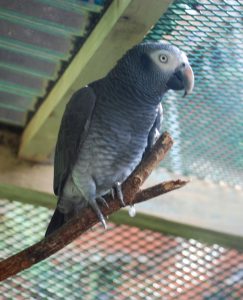
Sage. Oh no.
It was just just too much. I felt myself again close down.
Fortunately Tim was still with me for a few more days so we could talk through it all.
And slowly my sense of overwhelm and despair softened into a recognition of loss in my life.
The losses were several. I still could not walk out to my garden or to my outdoor studio. I couldn’t water my plants. I could not drive or hug my little dog Seurat even when he became ill. I couldn’t even open the back door to let my dogs run up the road. And now I was going to have to say goodbye to one of my dearest animal friends – Sage – because of something completely out of either of our control.
I felt like I had bumped into a place of deep vulnerability. A door had opened into a part of myself I rarely saw. And there was fear there too. I saw myself becoming afraid to be alone. Afraid I would fall and not be able to get up. Fear that I would not walk normally again. And fear that I would somehow disappear from the hearts and minds of those who didn’t see me around or hear from me as before. I feared that I would be forgotten.
And then to my surprise the sense of vulnerability smoothed out into a deep silence within. My quiet and slowed life began to imitate the incremental wound healing – cell by cell by cell. From somewhere beyond there came a knowing that I needed to heal even more deeply – beyond the wound and beyond my erratic emotions. My spirit needed to heal. I didn’t understand it at all on a scientific or rational level. But I understood it somewhere deep inside. My spiritual recovery was necessary for me to heal completely.
I didn’t know how to do it. Though I wished for a teacher or a guide, I was essentially alone in this. Somehow the guidance I craved would have to be found right here.
Could I access it?
“The wound is the place where the Light enters you.”
―

“Healing may not be so much about getting better, as about letting go of everything that isn’t you – all of the expectations, all of the beliefs – and becoming who you are. (in Bill Moyers’ Healing and the Mind)”
― Rachel Naomi Remen
Read more: Recovery – More Than Healing the Wound, Part 3 Depth

